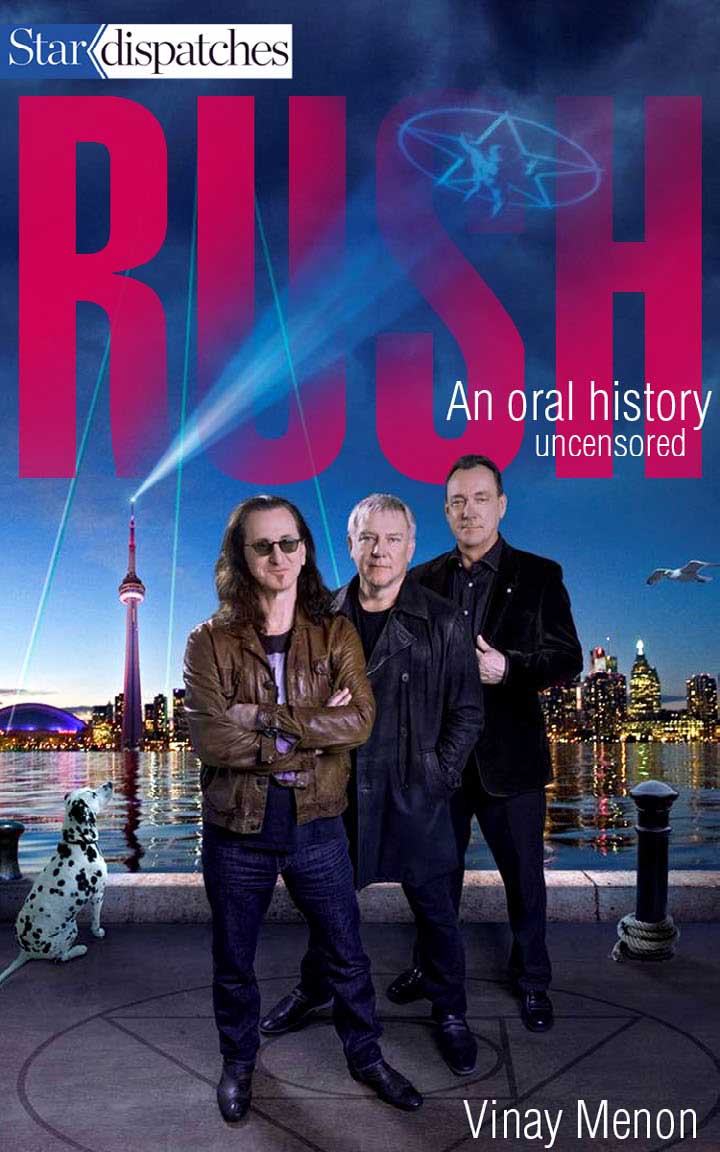Rush: An Oral History Uncensored
By Vinay Menon, Toronto Star Dispatches, April 18, 2013, transcribed by pwrwindows
The measure of a life is a measure of love and respect,
So hard to earn, so easily burned.
In the fullness of time,
A garden to nurture and protect ...
The treasure of a life is a measure of love and respect,
The way you live, the gifts that you give.
In the fullness of time,
It's the only return that you expect.
- "The Garden", Clockwork Angels (2012)
Introduction
No band has become more successful by caring so little about success.
That's just one of the contradictions of RUSH, the power trio that was born in 1974. Since they first played together inside a drab studio in Pickering, Ont., RUSH has been on a musical journey with no map, in the middle of a story with no foreseeable end.
Geddy Lee, Alex Lifeson and Neil Peart are always looking ahead, even when talking about the past.
And what a past they've had: 20 studio albums, eight live discs, more than 43 million records sold. RUSH ranks third for most consecutive gold or platinum studio albums by a rock band, behind only The Beatles and The Rolling Stones.
On the strength of tracks such as "Fly By Night," "Closer to the Heart," "La Villa Strangiato," "The Spirit of Radio," "Tom Sawyer," "Limelight," "Red Barchetta," "Subdivisions" and "New World Man," they have cultivated a global following that is united in feverish devotion to the prog rock demigods. The complex arrangements, the scorching riffs, the virtuoso musicianship, the almost pathological need for constant reinvention, the lyrical meditations that are at once philosophical and quotidian, all of this has produced a strange kind of alchemy.
Most bands have fans. RUSH has kindred spirits.
How did this happen? How did three Ontario lads get their first musical instruments around the age of 12 and then, about eight years later, begin to rewrite the rules of rock by shrugging off all commercial imperatives?
The walls at SRO/Anthem on Carlton St. in Toronto, the band's management headquarters for four decades, are festooned with gold and platinum records. To paraphrase a song lyric, these are the glittering prizes that arrived with no compromises.
RUSH has always done it their own way.
The office belonging to Ray Danniels - the band's manager since 1969, when he and they were skinny teens with big dreams - looks like a RUSH museum, crammed with framed concert tickets, memorabilia and pictures.
On a cold afternoon in March, vocalist and bass player Geddy Lee ambles into this office, a coffee in hand, and patiently talks me through the past 40 years. Even in those early days, when their prospects seemed bleak, music was the only plan.
"I had no idea what else I would do," said Lee, now 59. "I think that's a function of youth. At this age, I'd probably be much more practical. But at that age, thankfully, you just blindly move forward."
A few days earlier, in a diner on Bloor St. where he occasionally takes his grandchildren, guitarist Alex Lifeson arrived with his own candid memories, which he shared while nursing a pot of green tea.
To get drummer and lyricist Neil Peart's erudite take on this brotherhood, I flew to Los Angeles and then drove to Oxnard, California along the Pacific Coast Highway, parts of which were closed that morning due to a landslide.
With his vintage Aston Martin parked out front, Peart was ensconced inside a dark studio, not far from the factory where his custom drums are built. We sat on a leather couch, facing his elaborate kit, and his eyes sparkled while reminiscing about The Gene Krupa Story, the 1959 biopic about the American drummer that first awakened his own interest in percussion.
"All three of us really became galvanized by the power and freedom of rock music," Peart said, at the start of our interview. "What a great time to come of age in the mid-to-late '60s."
On April 18, 2013, RUSH will be inducted into the Rock and Roll Hall of Fame. While there have been no shortage of cultural accolades - Order of Canada (1997), Canada's Walk of Fame (1999), a Star on the Hollywood Walk of Fame (2010), the Governor General's Performing Arts Award (2012) - this one feels different, especially to the kindred spirits who've long complained about the band's conspicuous absence from the hallowed corridors of the rock shrine.
In typical fashion, Lee, Lifeson and Peart will head out on tour five days after the induction ceremony in Los Angeles. In retrospect, the band's name seems remarkably precise: they seem incapable of slowing down.
To understand this trajectory, from playing high schools in Southern Ontario to the Rock and Roll Hall of Fame, from those endless days as the opening act in small theatres to headlining sold-out stadiums across the planet, I interviewed more than two dozen insiders - spouses, siblings, parents, managers, record execs, long-time crew members - who are as much a part of the story as the band itself.
From these interviews, an oral history was stitched together, a framework of the past 40 years, buttressed with memories and anecdotes, reflections and insights of a band that continues to exude an honesty, integrity and loyalty that seems entirely at odds with the music industry.
What happened offstage in those early years? How did the band cope with the early trappings of fame? How did they nearly throw it all away? How did the need to innovate, to explore new terrain, cause tension in the studio? What happened after unimaginable tragedy nearly caused them to disband? What is the secret to the success they still don't care about? And most important, how do they remember moving forward, blindly but with eyes wide open, during this musical journey?
In the pages ahead, they will tell you.
Introduction reprinted with permission of the Toronto Star Dispatches.


